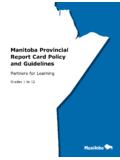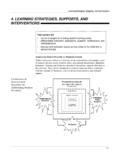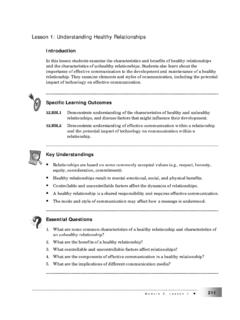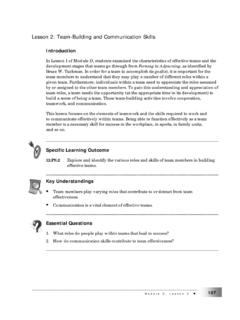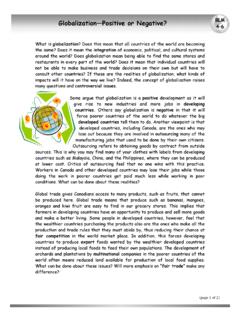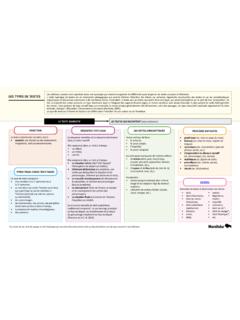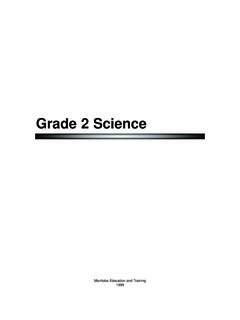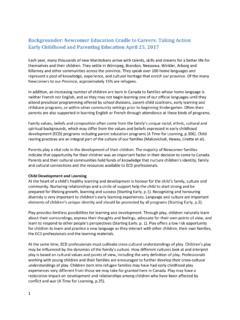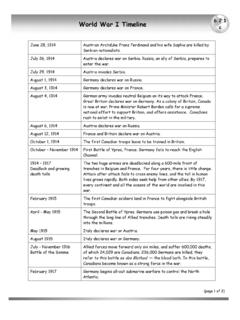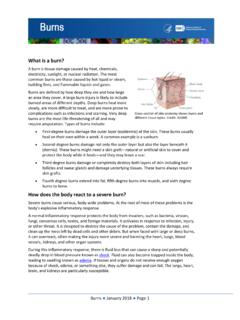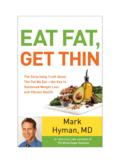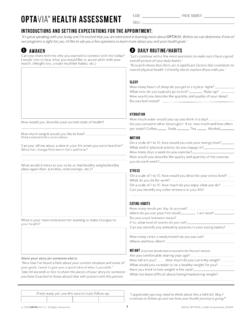Transcription of Lesson 1: Physical Activity for Optimal Health and Fitness
1 _____ Module B, Lesson 1 107 Lesson 1: Physical Activity for Optimal Health and Fitness Lack of Activity destroys the good condition of every human being, while movement and methodical Physical exercise save it and preserve it. Plato (427 347 BCE) Introduction Participating in Physical Activity and exercise are important Health maintenance strategies for people of all ages children, youth, adults, and seniors. If being physically active is to become a part of a person s lifestyle, it will be important to make a positive emotional connection to the activities of choice. In other words, there needs to be a feeling that Physical Activity is enjoyable and fun. Part of feeling that Physical Activity /exercise is fun is achieved by simply making it a habit.
2 This Lesson focuses on the many benefits of Physical Activity and exercise. The benefits are organized into three categories: Physical Fitness , Health , and mental-emotional benefits. _____ Specific Learning Outcome Evaluate the benefits of selected types of Physical activities in the development of Fitness and in the prevention of disease at various stages of life. Examples: relationship between aerobic Activity and cardiovascular disease, breast cancer, type 2 diabetes, mental Health ; relationship between weight-bearing activities and osteoporosis _____ Key Understandings Physical Activity contributes to Fitness , Health , and mental-emotional benefits. Specific benefits are associated with selected Physical activities.
3 There are key benefits of Physical activities at various life stages. _____ _____ 108 Grade 11 Active Healthy Lifestyles Essential Questions 1. What are the Health benefits of Fitness that affect five systems of the body ? 2. Why are the effects of exercise referred to as systemic effects? 3. What benefits of exercise affect the mental-emotional Health of an individual? 4. What benefits of Physical Activity may be different or the same for specific age groups? _____ Suggestion for Instruction / Assessment Benefits of Physical Activity and Exercise To help students think about and identify the numerous benefits of Physical Activity and exercise, have them reflect on the following: What makes or would make being physically active or exercising fun for you?
4 List as many benefits of Physical Activity and exercise as you can. Once students have had an opportunity to list the benefits individually, have them work in groups to compile a group list. Ask students to discuss and sort the identified benefits into three categories: Fitness , Health , and mental-emotional benefits. Discuss any identified benefits that do not fit into any of the three categories and have students create their own category. _____ Background Information Fitness Benefits of Physical Activity Regular Physical Activity increases the body s capacity and efficiency for work (performing movement), reduces the risk of injury and disease, and positively affects body composition (increased muscle mass, increased bone mass, and decreased fat mass).
5 Movement places increased demands on the cardiovascular, respiratory, muscular, skeletal, and nervous systems of the body . Each system benefits from an Activity plan that has consistent and progressive increases in the level of work intensity (activities that are harder to do and take longer to complete). The body s systems adapt to the increasing load, resulting in greater efficiency in these systems and thereby resulting in an increased ability to perform work. In other words, the body is able work longer and harder than it was able to before. After a person has achieved a new level of Fitness , everyday tasks are no longer as difficult as they once were. _____ Module B, Lesson 1 109 We do not have to spend hours in a gymnasium to gain the Fitness benefits of Physical Activity .
6 Every time we throw a ball, swim a lap, or climb a flight of stairs, our five main body systems are adapting. If these activities are consistent enough, our overall Fitness will improve. The human body responds well to consistent and progressive Physical Activity . Substantial improvements may be anticipated in cardiovascular and respiratory (heart, circulatory, and lung) function, muscular strength and endurance, flexibility, body composition, and the ability to respond to psychological stress. Some of the more noticeable changes resulting from Physical Activity may include increased heart and circulatory function and endurance, seen as a lower heart rate for a given Activity and a lower resting heart rate increased muscular strength, seen as an ability to lift heavier loads or an increased ease in lifting lighter loads increased muscular endurance, seen as the ability to execute more repetitions without rest increased bone strength, seen as a decreased risk of fracture or injury increased joint range of motion or flexibility, seen as an ability to reach or move into body positions impossible to attain previously increased Physical work capacity.
7 Seen as an ability to complete more work in a single bout ( , shovelling a driveway with lower risk of injury or adverse effect) improved body composition (more muscle, stronger bones, and less body fat) Health Benefits of Physical Activity The Health benefits of Physical Activity and exercise are well researched and documented. In addition to benefiting the cardiovascular, respiratory, muscular, skeletal, and nervous systems, Physical Activity and exercise also have a positive effect on the endocrine (hormonal responses) and immune (ability to defend against infection) systems. Because Physical Activity and exercise have such a wide-ranging effect on all the body s systems they have been referred to as having a systemic effect.
8 Systemic means system wide across all body systems. _____ 110 Grade 11 Active Healthy Lifestyles Evidence shows that regular Physical Activity and exercise can reduce the risk of many diseases and conditions, as well as having many other Health benefits: Physical Activity and exercise reduce the risk of diseases and conditions such as heart attack or heart disease second heart attack stroke colon, lung, breast, prostate, and many other cancers high cholesterol and triglycerides (fats) high blood pressure (hypertension) abnormal blood sugar levels type 2 diabetes osteoporosis (reduced bone density) pain arthritis and total hip or knee replacements depression and anxiety sleep apnea Physical Activity and exercise can also result in benefits such as improved pain tolerance improved self-esteem improved immune system better posture and balance decreased incidence of unintended falls greater energy improved sleeping habits faster recovery from injury or surgery increased high-density lipoproteins (HDL, or the good cholesterol) increased potential to achieve and maintain a healthy body weight by burning calories improved work capacity improved nervous system (better neurons)
9 _____ Module B, Lesson 1 111 Mental-Emotional Benefits of Physical Activity Physical Activity participation provides children and youth with opportunities for growth and development far beyond the obvious Health benefits. Participation in sport, exercise, and Physical Activity also helps individuals develop social skills, such as sharing, taking turns, cooperating, and learning about winning and losing develop Physical skills ( , coordination, posture, balance), locomotor skills ( , running), and manipulation skills ( , using a racquet or hockey stick), which contribute to a person s self-efficacy develop a sense of belonging (when doing things with others, either in casual or organized activities and sports) develop family relationships (when parents play and exercise with their children and support their children s sports)
10 Achieve academically in school prevent or control risky behaviours, such as the use of tobacco, alcohol, or other substances, unhealthy diets, or violence develop increased self-discipline, greater self-esteem, and a healthier body image increase opportunities to take on leadership roles, deal with adversity, and develop the ability to manage time _____ Suggestion for Instruction / Assessment Benefits of Physical Activities/Sports for Different Age Groups Divide the class into six teams. Ask two teams (each team working independently of the other) to identify at least five common Physical activities/sports in which children take part. Two different teams identify the same for adolescents, and two for adults. Have each team share its list of common Physical activities/sports with the other team assigned to the same age group.
